Imagine you want to buy a car. First, there are only two cars available and you make your decision. You like car A more than car B. But in the last moment, the vendor presents you a third option: Car C. According to economic principles, the third option should not change your preference of car A over car B. Yet, many empirical studies have shown that people’s preferences between two options can depend on a third alternative, a phenomenon referred to as context effects. In multi-attribute, multi-alternative, value-based decisions (as in the car example) these context effects appear and are not well met by traditional static decision theories.
In this review paper, we (Jörg Rieskamp and Sebastian Gluth) joined forces with Jerome Busemeyer from Indiana University and Brandon Turner from Ohio State University to discuss the advantages and the features of sequential sampling decision-making models that are able to account for context effects in multi-attribute, multi-alternative, value-based decisions. Despite important differences, all of these models assume that the process of multi-attribute, multi-alternative decision making uses the attribute features of options as inputs, compares those attributes across options and then integrates the comparisons across time to produce an accumulated preference for each option until a threshold is reached (see the Figure).
These sequential sampling models generally make better predictions than traditional economic choice models as they account for context effects. Furthermore, sequential sampling models make it possible to predict decision time and implications for eye movements and neural activation: There is evidence from fMRI studies that the posterior parietal cortex is linked to the feature processing of input options at the beginning of the decision process. Another important brain area is the ventromedial prefrontal cortex (vmPFC) which plays a role in the attribute comparison process. The dorsolateral and dorsomedial prefrontal cortex are thought to be implicated in the evidence accumulation process. However, to better understand the neural circuitry underlying multi-attribute, multi-alternative decisions, we argue that further studies that make use of EEG and its exquisite temporal resolution will be necessary.

Be the first to leave a comment. Don’t be shy.